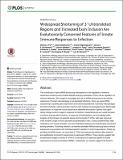Widespread Shortening of 3’ Untranslated Regions and Increased Exon Inclusion Are Evolutionarily Conserved Features of Innate Immune Responses to Infection
Author(s)
Baharian, Golshid; Pagé Sabourin, Ariane; Brinkworth, Jessica F.; Nédélec, Yohann; Foley, Joseph W.; Grenier, Jean-Christophe; Siddle, Katherine J.; Dumaine, Anne; Yotova, Vania; Johnson, Zachary P.; Lanford, Robert E.; Barreiro, Luis B.; Pai, Athma A.; Burge, Christopher B; ... Show more Show less
Downloadjournal.pgen.1006338.PDF (4.292Mb)
PUBLISHER_CC
Publisher with Creative Commons License
Creative Commons Attribution
Terms of use
Metadata
Show full item recordAbstract
The contribution of pre-mRNA processing mechanisms to the regulation of immune responses remains poorly studied despite emerging examples of their role as regulators of immune defenses. We sought to investigate the role of mRNA processing in the cellular responses of human macrophages to live bacterial infections. Here, we used mRNA sequencing to quantify gene expression and isoform abundances in primary macrophages from 60 individuals, before and after infection with Listeria monocytogenes and Salmonella typhimurium. In response to both bacteria we identified thousands of genes that significantly change isoform usage in response to infection, characterized by an overall increase in isoform diversity after infection. In response to both bacteria, we found global shifts towards (i) the inclusion of cassette exons and (ii) shorter 3’ UTRs, with near-universal shifts towards usage of more upstream polyadenylation sites. Using complementary data collected in non-human primates, we show that these features are evolutionarily conserved among primates. Following infection, we identify candidate RNA processing factors whose expression is associated with individual-specific variation in isoform abundance. Finally, by profiling microRNA levels, we show that 3’ UTRs with reduced abundance after infection are significantly enriched for target sites for particular miRNAs. These results suggest that the pervasive usage of shorter 3’ UTRs is a mechanism for particular genes to evade repression by immune-activated miRNAs. Collectively, our results suggest that dynamic changes in RNA processing may play key roles in the regulation of innate immune responses.
Date issued
2016-09Department
Massachusetts Institute of Technology. Department of Biological Engineering; Massachusetts Institute of Technology. Department of BiologyJournal
PLOS Genetics
Publisher
Public Library of Science (PLoS)
Citation
Pai, Athma A., et al. “Widespread Shortening of 3’ Untranslated Regions and Increased Exon Inclusion Are Evolutionarily Conserved Features of Innate Immune Responses to Infection.” PLOS Genetics, edited by Christine A. Wells, vol. 12, no. 9, Sept. 2016, p. e1006338.
Version: Final published version
ISSN
1553-7404